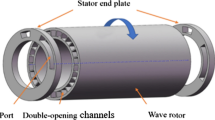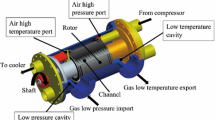Abstract
The wave rotor technology is an energy exchanging approach that achieves efficient energy transfer between gases without using mechanical components. The wave rotor technology has been successfully utilized in gas turbine cycle systems, gas expansion refrigeration and a variety of other industrial domains, yielding numerous researches and application outcomes. The structure of wave rotor passages inside which the energy exchange between gases is realized has an important impact on the equipment performance. In this study, based on gas wave ejection technology, the first application trials of an expansion wave rotor with curved passages were conducted. Additionally, the performance enhancing effect and mechanism of curved passages on the energy exchanging process were studied precisely by the combination of experimental and three-dimensional numerical simulation methods.
The experimental results demonstrate that the curved passage rotor (CIR rotor) employed in this research has a maximum isentropic efficiency of 61.6%, and the CIR rotor achieves higher efficiency than the straight passage rotor (STR rotor) on all working conditions in this study. Compared with the STR rotor, the maximum efficiency improving ratio of CIR rotor can exceed 14.2% at each experimental expansion ratio, and the maximum relative increments of ejection rate are more than 5%. In addition, the CIR rotor can also effectively increase the proportion of static pressure in total pressure of the medium-pressure gas, and reduce the device power consumption. The three-dimensional numerical investigations revealed the principle of gas ejection in the wave rotors and explained why the CIR rotor performed better. According to the numerical findings, the curved passages of the CIR rotor may effectively minimize various energy losses created in the processes of high-pressure gas incidence, exhausting flow in nozzle, and high-speed gas flow in the passages.
Similar content being viewed by others
Abbreviations
- c p :
-
specific heat capacity at constant pressure/J·(kg·K)−1
- d :
-
middle diameter of rotor/mm
- \(\vec F\) :
-
external volume forces/N
- h :
-
Passage height/mm
- l :
-
Passage axial length/mm
- m :
-
mass flow rate/kg·s−1
- n :
-
rotor rotational speed/r·min−1
- P con :
-
gas loading power consumption/W
- P s :
-
noload rotating power consumption of device/W
- P w :
-
total power consumption in the working state/W
- p :
-
total pressure/Pa
- p d :
-
dynamic pressure/Pa
- p h :
-
high pressure inlet/Pa
- p l :
-
low pressure inlet/Pa
- p m :
-
middle pressure outlet/Pa
- p s :
-
static pressure/Pa
- p t :
-
total pressure/Pa
- T :
-
temperature/K
- t :
-
time/s
- t open :
-
passage actual opening time/s
- t po :
-
time for passage full opening/ms
- \(\vec u\) :
-
velocity vector/m·s−1
- W com :
-
the actual work consumption for compressing low-pressure gas/W
- W coms :
-
the isentropic work consumption for compressing low-pressure gas/W
- W ep :
-
expansion work/W
- W eps :
-
expansion work generated in an isentropic expansion process/W
- w :
-
Passage width/mm
- x :
-
number of passages
- α :
-
expansion ratio
- β :
-
compression ratio
- γ :
-
adiabatic index
- ξ :
-
the ejection rate
- η :
-
the efficiencies of compression and expansion processes
- η com :
-
isentropic efficiency of compressing low-pressure gas
- η com :
-
isentropic efficiency of the expansion
- η ep :
-
work outputting process
- θ :
-
blade thickness/mm
- φ pin :
-
the inlet angle of passage/(°)
- φ pout :
-
the outlet angle of passage/(°)
- φ t :
-
viscous dissipation/m2·s−3
- φ tma :
-
average viscous dissipation/m2·s−3
- ψ ef :
-
efficiency improvement ratio
- ψ er :
-
ejection rate improvement ratio
- ψ msp :
-
static pressure lifting ratio
- ψ com :
-
relative compression ratio
- ω tma :
-
average vorticity intensity/s−1
- ω t :
-
vorticity intensity/s−1
- CIR:
-
curved-passage rotor
- GWE:
-
gas wave ejector
- STR:
-
straight-passage rotor
References
Akbari P., Nalim R., Müeller N., A review of wave rotor technology and its applications. Journal of Engineering for Gas Turbines and Power, 2006, 128(4): 717–735.
Iancu F., Piechna J., Müller N., Basic design scheme for wave rotors. Shock Waves, 2008, 18(5): 365–378.
Kentfield J., Wave rotors and highlights of their development. 34th AIAA/ASME/SAE/ASEE Joint Propulsion Conference and Exhibit, State of Ohio, America, 1998. DOI: https://doi.org/10.2514/6.1998-3248.
Tüchler S., Copeland C.D., Experimental results from the Bath μ-wave rotor turbine performance tests. Energy Conversion and Management, 2019, 189: 33–48.
Lapp K.P., Polanka M.D., Mcclearn M.J., Hoke J.L., Paxson D.E., Design and testing of a micro-scale wave rotor system. 53rd AIAA/SAE/ASEE Joint Propulsion Conference, Georgia, America, 2017.
Meyer A., Recent developments in gas turbines. Journal of Mechanical Engineering, 1947, 69(4): 273–277.
Berchtold M., Gardiner F. J., The comprex: a new concept of diesel supercharging. Turbo Expo: Power for Land, Sea, and Air. American Society of Mechanical Engineers, 1958, 79979: V001T01A016. DOI: https://doi.org/10.1115/58-gtp-16.
Azoury P H., An introduction to the dynamic pressure exchanger. Proceedings of the Institution of Mechanical Engineers, 1965, 180(1): 451–480.
Wilson J., Paxson D.E., Wave rotor optimization for gas turbine engine topping cycles. Journal of Propulsion and Power, 1996, 12(4): 778–785.
Paxson D.E., A numerical investigation of the startup transient in a wave rotor. Volume 1: Turbomachinery, 1997: 676–682.
Wilson J., An experimental determination of losses in a three-port wave rotor. Journal of Engineering for Gas Turbines and Power, 1998, 120(4): 833–842.
Hu D., Chen S., Yang J., Chen Z., Dai Y., Liu Z.R., Study on gas and wave in a receiving tube. Journal of Thermal Science, 2008, 17(2): 170–174.
Hu D., Liu P., Zhao W., Zhu C., Wang Y., Study on wall temperature distribution of oscillating tube. Journal of Thermal Science, 2009, 18: 246–252. DOI: https://doi.org/10.1007/s11630-009-0246-7.
Hu D., Yu Y., Liu P., Wu X., Zhao Y., Improving refrigeration performance by using pressure exchange characteristic of wave rotor. Journal of Energy Resources Technology, 2019, 141(2): 022004.
Hu D., Li R., Liu P., Zhao J., The design and influence of port arrangement on an improved wave rotor refrigerator performance. Applied Thermal Engineering, 2016, 107: 207–217.
Liu P., Hu D., Zhao J., Li R., The loss in charge process and effects on performance of wave rotor refrigerator. International Journal of Heat and Mass Transfer, 2016, 100: 497–507.
Kentfield J.A.C., The performance of pressure-exchange dividers and equalizers. Journal of Basic Engineering, 1969, 91(3): 361–368.
Kentfield J.A.C., An examination of the performance of pressure-exchanger equalisers and dividers. Imperial College London, London, Britain, 1963.
Zhao W., Hu D., Liu P., Dai Y., Zhao J., Influence of port angle on performance of gas wave ejector and prediction for optimal angle. CIESC Journal, 2012, 63(2), 572–577.
Zhao W., Hu D., Liu P., Dai Y., Zou J., Zhu C., Zhao J., The port width and position determination for pressure-exchange ejector. Journal of Engineering for Gas Turbines and Power, 2012, 134(6): 064502. DOI: https://doi.org/10.1115/1.4005982.
Zhao W., Examination of the flow and ejecting performance of pressure oscillating tube. Dalian University of Technology, 2012. DOI: https://doi.org/10.1016/j.applthermaleng.2018.07.073.
Hu D., Zhao Y., Wu T., Yu Y., Wang J., The experimental research and mechanism analysis on the influence of wave rotor rotational speed on the wave system and flow losses of gas wave ejector. Chemical Engineering & Processing: Process Intensification, 2019, 144: 107638. DOI: https://doi.org/10.1016/j.cep.2019.107638.
Akbari P., Nalim R., Review of recent developments in wave rotor combustion technology. Journal of Propulsion and Power, 2009, 25(4): 833–844.
Nalim M.R., Snyder P.H., Kowalkowski M., Experimental test, model validation, and viability assessment of a wave-rotor constant-volume combustor. Journal of Propulsion and Power, 2017, 33(1): 163–175.
Li J., Gong E., Yuan L., Li W., Zhang K., Experimental investigation on pressure rise characteristics in an ethylene fuelled wave rotor combustor. Energy & Fuels, 2017, 31(9): 10165–10177.
Iancu F., Müller N., Efficiency of shock wave compression in a microchannel. Microfluidics and Nanofluidics, 2005, 2(1): 50–63.
Deng S., Okamoto K., Teramoto S., Numerical investigation of heat transfer effects in small wave rotor. Journal of Mechanical Science and TeImperial College London chnology, 2015, 29(3): 939–950.
Kentfield J., Circumferential cell-dividers in wave-rotors. 34th AIAA/ASME/SAE/ASEE Joint Propulsion Conference and Exhibit, State of Ohio, America, 1998. DOI: https://doi.org/10.2514/6.1998-3397.
Pearson R.D., A pressure exchange engine for burning Pyroil as the end user in a cheap power from biomass system. Turbines à gaz. Congrès international des machines à combustion. 1983, 15: 931–966.
Welch G., Paxson D., Wave turbine analysis tool development. 34th AIAA/ASME/SAE/ASEE Joint Propulsion Conference and Exhibit, State of Ohio, America, 1998. DOI: https://doi.org/10.2514/6.1998-3402.
Lear W.E., Kielb R.P., The effect of blade angle design selection on Wave-Turbine engine performance. Turbo Expo: Power for Land, Sea, and Air. American Society of Mechanical Engineers, 1996, 78729: V001T01A078. DOI: https://doi.org/10.1115/96-GT-259.
Jagannath R.R., Bane S.P.M., Razi N.M., Numerical modeling of a wave turbine and estimation of shaft work. Journal of Fluids Engineering, 2018, 140(10): 101106. DOI: https://doi.org/10.1115/1.4040015.
Piechna J., Dyntar D., Numerical investigation of the wave disk Micro-Engine concept. International Journal of Gas Turbine, 2008, 2(1): 1–8.
Akbari P., Agoos I., Two-Stage wave disk engine concept and performance prediction. SAE Technical Paper, 2017. DOI: https://doi.org/10.4271/2017-01-2046.
Jagannath R., Bane S.P., Feyz M.E., Nalim M.R., Assessment of incidence loss and shaft work production for wave rotor combustor with non-axial channels. 55th AIAA Aerospace Sciences Meeting, State of Texas, America, 2017, pp. 1749. DOI: https://doi.org/10.2514/6.2017-1749.
Tüchler S., Copeland C.D., Validation of a numerical Quasi-One-Dimensional model for wave rotor turbines with curved channels. Journal of Engineering for Gas Turbines and Power, 2020, 142(2): 021017. DOI: https://doi.org/10.1115/1.4044286.
Eidelman S., Gradual opening of skewed passages in wave rotors. Journal of Propulsion and Power, 1986, 2(4): 379–381.
Tüchler S., Copeland C.D., Experimental and numerical assessment of an optimised, non-axial wave rotor turbine. Applied Energy, 2020, 268: 115013. DOI: https://doi.org/10.1016/j.apenergy.2020.115013.
Hu D., Zhao Y., Wu T., Li Z., Wang J., The complete performance map of gas wave ejector and analysis on the variation laws and limitation of performance. Journal of Engineering for Gas Turbines and Power, 2020, 142(2): 021012.
Hu D., Yu Y., Liu P., Enhancement of refrigeration performance by energy transfer of shock wave. Applied Thermal Engineering, 2018, 130: 309–318.
Tüchler S., Copeland C.D., Numerical optimisation of a micro-wave rotor turbine using a quasi-two-dimensional CFD model and a hybrid algorithm. Shock Waves, 2021, 31(3): 271–300.
Menter F.R., Egorov Y., The scale-adaptive simulation method for unsteady turbulent flow predictions. Part 1: theory and model description. Flow, Turbulence and Combustion, 2010, 85(1): 113–138.
Bai J.Q., Chen W., Yang Z., Application of a turbulence model based on von karmen length scale in steady and unsteady flow simulation. Engineering Mechanics, 2014, 31(11): 39–45, 52.
Kurec K., Piechna J., Gumowski K., Investigations on unsteady flow within a stationary passage of a pressure wave exchanger, by means of PIV measurements and CFD calculations. Applied Thermal Engineering, 2017, 112: 610–620.
Wilson J., An experimental determination of losses in a three-port wave rotor. Journal of Engineering for Gas Turbines and Power, 1998, 120(4): 833–842.
Acknowledgment
This study is supported by the National Key Research and Development Program of China (No. 2018YFA0704600)
Author information
Authors and Affiliations
Corresponding author
Rights and permissions
About this article
Cite this article
Zhao, Y., Li, H. & Hu, D. Experimental and Numerical Research on Strengthening the Performance of Wave Rotor Equipment with Curved Passages. J. Therm. Sci. 32, 59–80 (2023). https://doi.org/10.1007/s11630-022-1704-8
Received:
Published:
Issue Date:
DOI: https://doi.org/10.1007/s11630-022-1704-8




